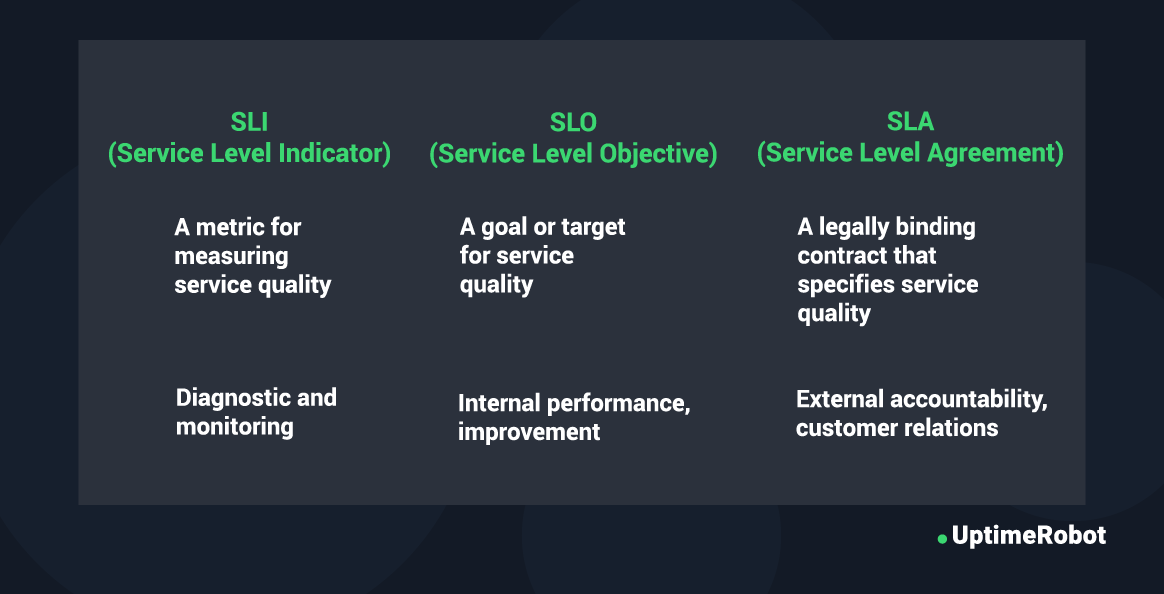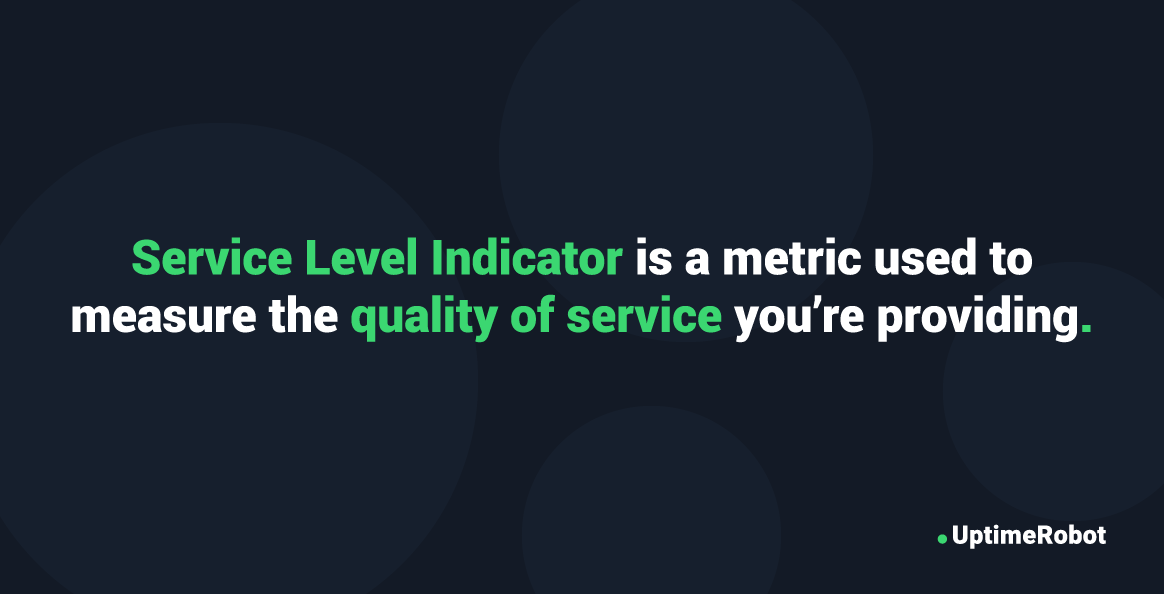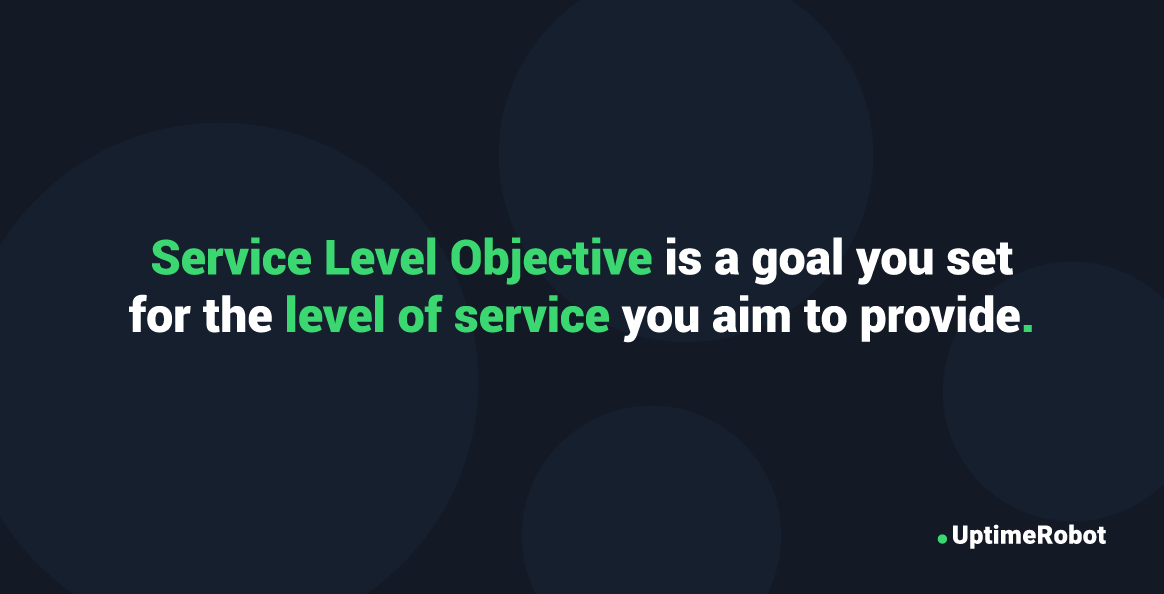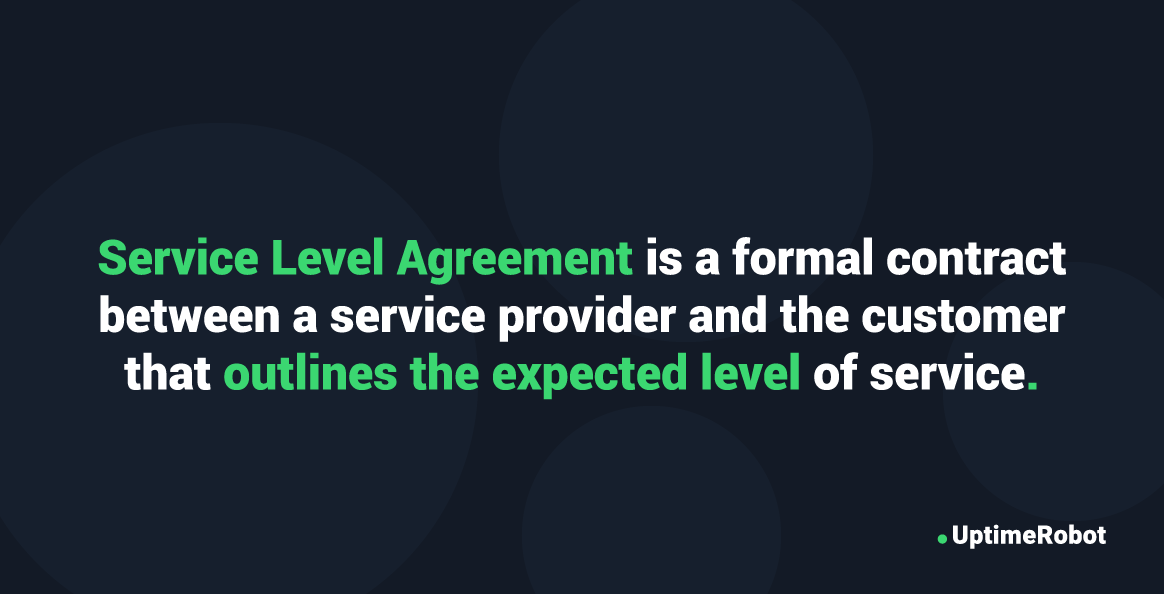Quick links
When it comes to managing services effectively, terms like SLA, SLO, and SLI are often thrown around like confetti at a parade.
They’re in meetings, in documents, and even in casual office conversations. But if you’re new to the field or simply haven’t had the chance to dig into these acronyms, they can feel like a bewildering alphabet soup.
And they can’t be missing on an uptime monitoring blog such as ours!
So, what do these terms really mean?
They’re not just jargon designed to make industry insiders feel smart.
Each acronym serves a specific purpose, helping to measure, manage, and guarantee the quality of the service being provided.
In this article you’ll learn:
- Their importance in service management
- The role of metrics
- How they work together
- Choosing the right one for your needs
- Their impact on service quality and reliability
Why should you care?
Because whether you’re a service provider looking to stand out in a crowded market, a manager aiming to optimize team performance, or a customer seeking reliable service, these terms offer a structured way to set expectations and measure outcomes.
Today we’re here to break it down for you, to demystify these terms and help you understand how to use them to improve service quality, foster better relationships, and drive business success.
So, keep reading to find out which one (or ones) are most relevant to your needs.
A Brief Overview of the Terms SLA, SLO, and SLI
SLA (Service Level Agreement)
An SLA is a formal contract between a service provider and the end-user that spells out the level of service that the customer can expect.
One of the ways to showcase your uptime is by using a public status page with the uptime history.
It’s the promise that a company makes to deliver a particular quality of service, often underpinned by penalties for failure to meet these standards.
SLO (Service Level Objective)
On the other hand, service level objectives are more like goals rather than promises. An SLO represents a target level of service that the service provider aims to deliver.
While it’s often used internally, it can still have implications for customer experience.
SLI (Service Level Indicator)
A service level indicator serves as a measurable metric, such as latency or error rate, that acts as a yardstick for assessing the quality of service.
Think of it as a health indicator for a specific service or a way to measure how close you are to meeting your SLO.
Now that we’ve got the basics down, let’s get into why these metrics matter.
Why Metrics Matter?
Metrics are more than just numbers on a dashboard.
They’re essential tools for evaluating performance, identifying problem areas, and driving improvement.
Without relevant metrics, it’s like driving a car blindfolded, you don’t really know where you’re going, and you’re likely to crash.
By using metrics effectively, companies can:
- Track performance over time
- Identify weak spots in the service chain
- Make data-driven decisions for service improvement
- Align team efforts with business goals
- Improve customer experience through consistent quality
Metrics serve as the backbone for SLAs, SLOs, and SLIs, providing quantifiable measures that make these agreements and objectives meaningful.
TIP: Start tracking your uptime to improve your metrics with UptimeRobot.
SLI: Service Level Indicators
So what exactly is an SLI?
SLIs give you a tangible way to track how well you’re doing in meeting your service goals or SLOs. This could be anything from how fast a web page loads (latency) to how often a service fails (error rate).
Components and Examples
Now, let’s talk about what goes into an SLI. Typical metrics used as SLIs might include:
- Latency: The time it takes to complete a request.
- Error rate: The percentage of requests that result in errors.
- Availability: The amount of time a service is accessible and operational.
- Throughput: The number of requests a service can handle over a given time period.
These metrics help paint a picture of your service quality from multiple angles, allowing you to better understand where to focus your improvement efforts.
Who Needs an SLI?
If you’re in any business that provides a service, which is pretty much every business, you’ll want to consider SLIs.
They’re particularly crucial for:
- IT managers who need to assess system performance.
- Customer service teams aiming to improve client experience.
- Executives making decisions based on performance data.
- Development teams optimizing system functionality.
Pros & Cons of SLIs
Like most things in life, SLIs have their upsides and downsides.
Pros:
- They offer quantifiable measures of service quality.
- They help in the identification of problem areas.
- They can be tied to incentives or penalties in an SLA.
Cons:
- Too many SLIs can become overwhelming and counterproductive.
- They’re only as good as the data that feeds them, meaning poor data can lead to inaccurate assessments.
- Not all aspects of service quality can be easily measured.
So that’s the lowdown on SLIs. Next, we’ll explore SLOs.
SLO: Service Level Objectives
Definition
Unlike an SLA, which is a legally binding agreement, an SLO is more of an internal benchmark. However, it still plays an important part in shaping customer expectations and experience.
Components and Examples
Just like SLIs, SLOs are built around specific metrics. These could include:
- Average response time should be below 200 milliseconds.
- The error rate must be less than 1%.
- 99.99% uptime for a particular service.
These targets serve as guideposts for your service team, giving them something concrete to aim for.
Importance in Service Management
Why are SLOs so vital in service management?
Here are a few reasons:
- They help align team efforts toward common goals.
- SLOs offer a framework for continuous improvement.
- They help to prioritize resources and focus.
If you can’t measure it, you can’t manage it, right?
SLOs give you something quantifiable to track and improve upon rather than a vague and undefined goal or idea.
Pros & Cons of SLOs
Every rose has its thorns, and SLOs are no exception.
Pros:
- Provide clear targets for service quality.
- Adaptable and can be revised as your service evolves.
- Can be used to communicate performance expectations to stakeholders.
Cons:
- Can create a culture of meeting the “minimum standard” if not properly managed.
- Excessive focus on SLOs might ignore other qualitative aspects of service.
- If set unrealistically high, they can be demotivating for the team.
SLA: Service Level Agreements
Now let’s get into SLAs, the heavy-hitters in the world of service management.
This is akin to making a promise and backing it up with a legally binding document. Missing the mark can mean penalties or even losing a client, so SLAs are serious business.
Components and Examples
SLAs often contain the following elements:
- Detailed description of the service provided
- Metrics for measuring the service, often tied to SLOs and SLIs
- Remedies or penalties for not meeting agreed service levels
- Duration and terms for revisiting the agreement
Examples of SLA metrics might include:
- 99.9% uptime guarantee
- Average response time under 300 milliseconds
- Error rates not to exceed 0.5%
Legal Implications
Unlike SLOs, SLAs come with legal obligations.
Failure to meet the standards can result in penalties, which could be financial or could involve offering additional services for free to make up for the lapse.
It’s crucial to understand what’s at stake before entering into or creating an SLA.
Importance in Business Relationships
SLAs go beyond just numbers, and they’re about building and maintaining trust. A well-constructed SLA:
- Sets clear expectations for both parties
- Fosters accountability
- Creates a framework for evaluating service and making improvements
Pros & Cons of SLAs
Let’s look at some of the pros and cons of having an SLA.
Pros:
- Legal assurance and protection for both parties
- Helps in maintaining high levels of service quality
- Sets a precedent for future business dealings
Cons:
- Can be complex and time-consuming to draft
- Potential for legal disputes if terms are not clear
- They can create pressure to meet contractual obligations over focusing on broader quality improvements
By now, you’ve probably noticed that SLAs, SLOs, and SLIs are intertwined, each playing a role in effective service management.
Differences Between SLA, SLO, and SLI
Here’s a straightforward table to highlight the main differences:
| Aspect | SLI (Service Level Indicator) | SLO (Service Level Objective) | SLA (Service Level Agreement) |
| What it is | A metric for measuring service quality | A goal or target for service quality | A legally binding contract that specifies service quality |
| Used by | Service providers, teams within an organization | Service providers, teams within an organization | Service providers and customers |
| Legal Implications | None | None | Yes, can result in penalties |
| Components | Metrics like latency, error rate, etc. | Metrics and time periods | Metrics, remedies, terms of agreement |
| Focus | Diagnostic and monitoring | Internal performance, improvement | External accountability, customer relations |
SLI vs. SLO
The difference between SLI and SLO is essentially diagnostic versus aspirational.
An SLI tells you how your service is performing, while an SLO sets a target for how you’d like it to perform. SLIs are the foundation upon which SLOs are built.
SLO vs. SLA
While SLOs are goals and targets used internally, SLAs are externally focused, typically between a service provider and a customer.
SLOs can be part of an SLA, setting the metrics that the service provider is obligated to meet.
SLI vs. SLA
SLIs are specific metrics that could be part of an SLA.
They play a role in the broader contractual context by providing measurable criteria for assessing service quality. In an SLA, failing to meet the SLI metrics could have legal implications.
Which Should You Use – SLA, SLO, or SLI?
After all this, you might be wondering which one you should use.
The answer is that it depends on your role and what you’re looking to achieve:
- Use SLIs if you’re looking to measure and monitor the performance of specific aspects of your service.
- Go for SLOs if you’re setting internal performance goals for your team or service.
- Opt for SLAs if you’re a service provider establishing formal commitments with your clients.
Each has its own place and purpose, and often they work best when used together in a layered approach to service management.
Conclusion
To sum things up, understanding the differences between SLA, SLO, and SLI is important for anyone involved in service management, whether you’re a service provider, part of an internal team, or a customer.
- SLIs provide you with metrics to gauge how your service is doing, like the vitals in a health checkup.
- SLOs act as your fitness goals, providing a target for what those vitals should look like.
- SLAs are the formal agreements that bring everything full circle, offering both the service provider and the customer legal protections and a clear framework for what to expect from the service.
In a way, these three acronyms serve as the building blocks for effective, accountable, and high-quality service management.
Whether used individually or in tandem, they offer a well-rounded framework for delivering exceptional service and continually striving for improvement.
So, the next time you come across these terms, you’ll know not just what they mean but also how to use them to your advantage.



